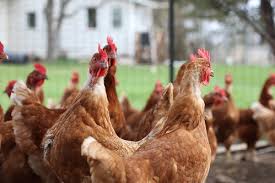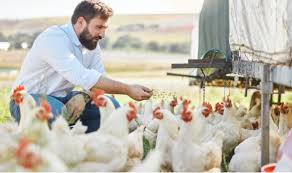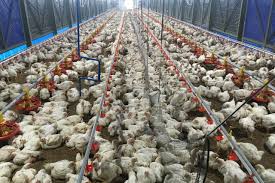In this article, the discussion on poultry production and the analysis of poultry management systems will be covered in detail.
Introduction to Poultry Keeping
Livestock consists of cattle, pigs, sheep, goats, poultry, and fish farming. Traditionally, most families in Nigeria engage in one form of livestock production or another. Poultry refers to a collection of domesticated birds, including chickens (domestic fowls), turkeys, ducks, geese, pigeons, guinea fowls, etc.
Domestic fowls consist of local and exotic breeds, which together make up about 85% of Nigeria’s poultry population. As a result, the term “poultry” is sometimes used synonymously with “fowls.” Ducks are usually kept in confined areas of the backyard with provisions for artificial ponds, although some are allowed to roam freely like local fowls.
Guinea fowls are naturally wild, often bred and raised in the bushes of Northern Nigeria, where approximately 95% of them are found. They are primarily reared in semi-free-range environments.
Pigeons and geese are more commonly kept as pets than for other purposes. Fewer than one million turkeys are raised in Nigeria, typically under free-range conditions.
The poultry industry in Nigeria can be grouped into the following categories:
i. Egg production
ii. Table meat production
iii. Poultry feeds
iv. Manufacturing of poultry equipment
v. Processing or marketing of poultry products
Read Also: How To Start A Piggery Project
The Importance of the Poultry Industry

Poultry production holds equal importance to agriculture itself. Poultry provides meat and eggs, essential sources of animal protein for a balanced diet and healthy growth. The poultry sector significantly contributes to the income of individual farmers and the country’s Gross Domestic Product (GDP). Poultry farmers generate substantial income from the sale of broilers, eggs, and spent layers.
Traditionally, most households in Nigeria have engaged in some form of poultry farming. Commercial poultry farmers employ full-time laborers on their farms, and other branches of the poultry industry, such as processing and marketing of poultry products, also involve full-time workers.
Poultry products, particularly eggs and meat, serve as raw materials for other industries, such as bakeries and paint production. Poultry droppings are valuable organic manure for soil, either through composting or direct application to plant roots as farmyard manure.
The initial costs of poultry production are low, making it accessible to small-scale operators. Because of the low cost per bird, poultry is often used in laboratories for research purposes.
Breeds of Domestic Fowls
The breeds of domestic fowls in Nigeria can be classified into two main categories: local dwarf chickens and exotic breeds.
1. Local Dwarf Fowls
Local dwarf chickens are indigenous to Nigeria and are kept throughout the country by nearly every rural household for both egg and meat production. These fowls grow slowly and take a longer time to reach slaughter weight compared to exotic breeds.
2. Exotic Breeds
Exotic fowls are kept by relatively few Nigerians, typically in large commercial farms and small-scale operations. The choice of breed or strain depends on the purpose of production. For egg production, the best breeds available in Nigeria include:
i. Harco
ii. Babcock
iii. Leghorn
iv. Rangers
v. Thornbers
vi. Hylines
For meat production (broilers), the following breeds are commonly used:
i. Cobb
ii. Super-o-broilers
iii. Red Sussex
iv. Cornish
v. Mid-Atlantic
vi. Dorking
For dual-purpose breeds (those suitable for both large body size and egg production), the following are common:
i. Plymouth Rock
ii. Rhode Island Red
iii. Light Sussex
Common Poultry Terms
| Poultry Term | Chicken | Turkey | Duck |
|---|---|---|---|
| Adult Male | Cock | Tom | Drake |
| Adult Female | Hen | Turkey Hen | Duck |
| Young Male | Cockerel | Tom | Drake |
| Young Female | Pullet | Poult | Duckling |
| Group of Adults | Flock | Flock | Flight |
| Group of Young Ones | Chicks | Poult | Ducklings |
| Castrated Male | Capon | – | – |
| Sterilized Female | Pollard | – | – |
| Flesh | Chicken | Turkey | Duck |
| Mating | Treading | Treading | Treading |
| Pregnancy | In-lay | In-lay | In-lay |
| Parturition | Laying and Hatching | Laying and Hatching | Laying and Hatching |
Systems of Poultry Management

Poultry management generally involves three main methods:
- Extensive System
- Semi-Intensive System
- Intensive System
1. The Extensive System
This system is mostly applied to the management of local breeds, where birds are exposed to free pasture and sunshine. The open range system, also known as the free-range system, is the most common method under this system.
2. Open or Free-Range System
In this system, the birds are left to roam freely during the day, with accommodation provided for them at night. They are occasionally fed sorghum or maize, particularly in the morning.
i. Advantages:
i. Low labor and capital costs
ii. Exposure to a variety of food sources
iii. Minimizes disease outbreaks among the flock
iv. Droppings improve soil fertility
ii. Disadvantages:
i. Exposure to pests and diseases
ii. Risk of theft and attacks by wild animals
iii. Low egg production and difficulty in locating eggs
iv. Feasible only where land-to-poultry population ratio is low
3. The Semi-Intensive System
The semi-intensive system allows birds some outdoor movement, while also ensuring they receive adequate care. Two common methods under this system include:
i. The Folding System
In this method, chicks (about 40 birds) are kept in movable houses, where they are supplied with food, fresh grass, and water. The houses are moved daily.
ii. Restricted Range System
This method is similar to the folding system, but the poultry house is not movable. The house is built permanently with a fenced area for exercise.
A. Advantages of Semi-Intensive System:
i. Reduced risk of parasite infection
ii. Close observation of birds
iii. Reduced exposure to thieves and predators
iv. Easy to locate eggs
v. Even distribution of droppings to the land
B. Disadvantages:
i. High cost of housing and management
ii. Potential for underfeeding due to restricted movement
iii. Risk of disease outbreaks within the housing unit
4. The Intensive System
The intensive system is typically used in commercial poultry farming, where birds are kept permanently in one place, and feeds, water, and other materials are brought to them. The two popular methods under this system are:
i. Deep Litter System
This system involves constructing permanent structures for the birds, with the floor covered in materials such as sawdust, straw, or wood shavings. The birds can roam within the confined but well-ventilated house.
Advantages:
i. Less expensive than the battery cage system
ii. Litter provides essential micro-organisms that contribute to vitamin B complex
iii. Reduced risk of disease spread
iv. Birds are safer from theft and predators
Disadvantages:
i. Higher costs compared to the extensive system
ii. Disease outbreaks are possible if the litter becomes wet
iii. Culling unproductive layers is difficult
iv. Lack of exercise can lead to weakness in exotic breeds
ii. Battery Cage System
In this system, birds are confined to individual compartments within permanent structures. Cages vary in size, with space for one, two to five, or more birds per compartment.
Advantages:
i. Suitable for high-density bird farming
ii. Reduced risk of disease spread due to separation of droppings
iii. Easier management compared to deep litter systems
Disadvantages:
i. Higher initial cost compared to deep litter systems
ii. Not suitable for cockerels and broilers
iii. Lack of exercise for the birds
Read Also: Positive and Negative Effects of Drinking Garri
Poultry House

A poultry house is crucial in the intensive system, providing protection from thieves, predators, adverse weather conditions, and parasites. Proper housing enables better management, such as easier egg collection and effective parasite control.
Siting of Poultry Farm
Choosing the right site for a poultry farm is essential for success. The site should meet the following conditions:
1. Accessibility: The farm should be easily accessible for the farmer and customers.
2. Topography: The site should be well-drained and shielded from strong winds.
3. Water Availability: A steady water supply is critical for poultry management.
4. Proximity to Other Farms: The farm should be at least 100 meters away from existing poultry farms to avoid disease transmission.
5. Provision of Shade: Trees near the poultry house help reduce temperature and serve as windbreaks.
Do you have any questions, suggestions, or contributions? If so, please feel free to use the comment box below to share your thoughts. We also encourage you to kindly share this information with others who might benefit from it. Since we can’t reach everyone at once, we truly appreciate your help in spreading the word. Thank you so much for your support and for sharing!

